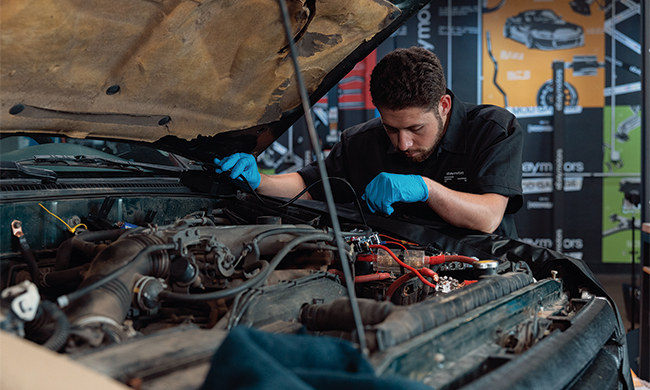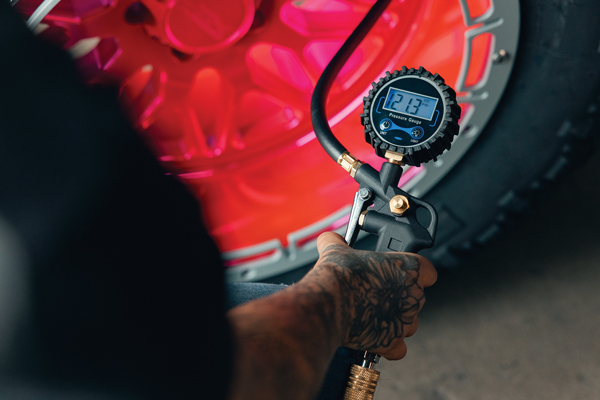Live Better
3 tips to take control of car maintenance

(Family Features) Economic factors made 2023 a record year for motorists, but not in ways that helped most families’ household budgets.
The average price of a new car peaked at nearly $50,000 while the average age of cars on the road surpassed 12 years, a record, according to S&P.
Rising costs for new cars and an aging fleet of vehicles on the road go hand-in-hand and, for most drivers, this means staying on top of vehicle maintenance is crucial. Yet even maintenance has become more difficult as the cost of parts and labor increase, leaving drivers with a sometimes daunting list of automotive DIY projects or parts to source when their mechanic is out of stock.
Common Fears About Automotive DIY For people new to car maintenance and repair, getting started can feel overwhelming. Because many families count on their cars to get where they need to go, it seems like a lot could go wrong with an average of 30,000 parts under the hood of a gasoline-powered vehicle.
For people new to car maintenance and repair, getting started can feel overwhelming. Because many families count on their cars to get where they need to go, it seems like a lot could go wrong with an average of 30,000 parts under the hood of a gasoline-powered vehicle.
Consider these common situations that could make someone hesitant to take on a DIY project:
- Finding the best place to get parts to fit your needs
- Being unsure if a part is high enough quality to last and keep your car on the road
- Not knowing if the part you ordered will fit your car
For most, these fears boil down to being unsure if a part is right for the job, or if they’re skilled enough to install it.
Tips to Get the Repair Done Right
Now, more automotive parts and accessories retailers offer tools to help guide DIYers toward the right inventory for their needs. From brick-and-mortar shops to online marketplaces like eBay Motors, they can enjoy access to more resources to help find the exact part and good value:
- Consider shopping online: While physical retailers may have parts that work in a pinch, they may not be the best part for a project or offer the best value. Searching online retailers can provide access to millions of parts and accessories – including hard-to-find and discontinued items – from trusted car manufacturers and reliable aftermarket part brands.
- Look for fitment guarantees: There are few things more frustrating than being halfway through a repair only to learn a part doesn’t fit. To help ensure you’re buying with confidence, the eBay Guaranteed Fit program allows users to add a vehicle to “My Garage” then quickly and easily search for parts. If there’s a green “Fits” check, you can rest assured it’s guaranteed to fit or your money back.
- Take advantage of services and educational tools: Some online parts destinations offer features on-site or via app that connect you with licensed mechanics live if you’re unsure of how to approach a repair or maintenance, from something simple like a filter change to help with more advanced jobs, like replacing spark plugs. When it comes to sourcing and installing parts like tires, look for marketplaces that offer a wide selection of top brands and services that ship your order straight to your local shop for convenient installation.
With the right resources, car projects can feel more manageable. To get started, visit eBayMotors.com to find how-to resources, parts and accessories to tackle some DIY projects, including filters, wiper blades, spark plugs, batteries, light bulbs and more.
SOURCE:
eBay Motors
Live Better
Laying the foundation for writing

(Family Features) Learning to write is one of the defining milestones of early childhood, but it doesn’t happen all at once. Children build writing skills over time, from indecipherable scribbles to writing letters and words. While children progress at their own pace, families can help foster early writing development.
Dr. Lauren Loquasto, senior vice president and chief academic officer at The Goddard School, and Dr. Sonia Cabell, professor of reading education at Florida State University and member of The Goddard School’s Educational Advisory Board, provide this insight and guidance for families.
Early Writing Milestones
Writing begins in early toddlerhood, around 18-24 months. The earliest developmental milestone is when children scribble on paper with a crayon.
By 2-3 years old, children often draw shapes and narrate their writing. Parents should show genuine interest to help build confidence and interest. Ask your children to read what they write, as this helps make the connection that marks on paper represent thoughts and ideas. It’s not expected for children younger than 3 to write identifiable letters. Instead, encourage them to make marks on paper without constraint, allowing them to freely express themselves.
Around ages 3-5, children begin to move from writing (making marks) to handwriting, which is the formalized motion of making numerals and letters in recognizable forms. It’s vital for parents to value their children’s writing no matter what appears on the paper and provide opportunities for them to regularly engage in writing. Children at this age tend to write letters in different ways. It’s common, for example, for letters to appear backwards or from right to left. These are not causes for concern; this is a natural part of the development process.
Writing Supports Reading (and Vice Versa)
Reading and writing skills develop in tandem, reinforcing each other. Through writing, children experiment with how written language works, learning English moves from left to right and top to bottom. By estimating spelling – using their knowledge of letter shapes and sounds to attempt to write words – they are beginning to break the code of reading. Moreover, when children are composing stories, they are supporting comprehension and oral language growth, which are critical for reading development.

Encourage Writing at Home
Make writing part of everyday life. While ensuring paper and writing utensils are accessible is a start, materials alone won’t spontaneously create writing experiences. Children naturally want to engage with things they see, so parents and older siblings should serve as writing models. For example, when writing a grocery list, ask your children to write their own lists. When you’re writing a thank-you note, have them write their own.
The development of fine motor skills is also essential. One way to do this is provide tools like chopsticks or tongs that require them to use their forefinger and thumb in a pinching motion; this strengthens the hand muscles that are used to write. Also encourage play with small toys like blocks or beads that engage the hands in different ways. As fine motor skills improve, it becomes easier to grip writing utensils and write for extended periods.
Writing Tools
From apps to workbooks, countless tools and resources tout their ability to help children learn to write. Be wary. Typing on a tablet or computer is no substitute for learning to write by hand. Multiple studies have shown that writing – not typing – better promotes cognitive and literacy development.
Avoid activities like workbooks that require repetitive writing of letters over and over, as this inhibits creativity and experimentation. These activities can cause children to fear making mistakes, which can lead to anxiety, frustration and a loss of interest. The best tools are often the simplest: a small writing utensil (not big or bulky; children have small hands and need appropriately sized utensils) and a blank piece of paper.
Remember, children develop at their own pace. Provide encouragement and focus on effort, not perfection.
To watch a writing webinar featuring Loquasto and Cabell and access additional parenting resources, visit the Parent Resource Center at GoddardSchool.com.
Photos courtesy of Shutterstock
SOURCE:
Live Better
Keep your summer entertaining simple, fun

5 expert ways to make the most of seasonal gatherings
(Family Features) From summer holidays and pool parties to spontaneous backyard barbecues with friends and neighbors, the hottest season of the year brings people together. When it’s your turn to host, make the most of the occasion by setting up your space to maximize the fun while showing off your festive side.
“Summer is hands down my favorite time to host,” said Kristina Zias, lifestyle, beauty and fashion expert and mom. “I love any excuse to bring people together and – let’s be real – I’m always looking for a reason to throw a party. The key is keeping things low stress for the host and making sure guests feel comfortable the second they walk in.”
This season, Zias and Glade are teaming up to share some of her favorite summer entertaining tips, which are simple, low-effort ways to make every gathering feel special. Whether you’re planning a full-blown backyard bash or hosting a few friends for drinks, Zias’ go-to ideas are all about setting the mood and enjoying the moment.
1. Set the Scene Without the Stress
To achieve a beautiful scene and make cleanup a breeze, try using disposable plates, utensils, napkins and cups in red, white and blue. A self-serve drink station with strawberry-infused water and a table of colorful fruit skewers adds charm without requiring much prep.

2. Tap Into Nostalgia Through Scent
Scent can instantly transport guests back to cherished summer memories, making it a powerful way to set the tone and spark conversation. Zias suggests using home fragrances to do just that. The new Glade Americana collection, available exclusively in stores and online at Walmart, features three limited-edition scents inspired by nostalgic summer traditions like beach trips, ice pops and garden-fresh fruit. Masterfully crafted to help bring summer to every room of your home, they’re designed to evoke warm-weather traditions.
- Berries & Cream: Scents of a classic American summer treat spring to life in a picnic-perfect blend of apple, red berries, apricot, vanilla and sweet cream.
- Summer Pops: Reminisce on childhood memories of a cool ice pop on a warm summer day with bright notes of Brazilian orange, pineapple, strawberry, white peach and sandalwood.
- Beach Life: Transport yourself to a favorite summer vacation spot by the ocean with a breezy mix of sea salt, driftwood, white moss and white peony.
“These seasonal scents can help you evoke nostalgic memories and bring that summer energy into any room of your home,” Zias said. “They make everything feel a little more special and, honestly, they just make me happy.”
3. Keep It Simple and Guest-Friendly
Part of summer’s appeal is its easygoing vibe, so there’s no need to overdo it with complicated snacks or overwhelming decor. Lean into the simplicity of the season with ready-to-serve bites that can please guests of all ages, like berries, sliced or cubed watermelon, meat and cheese trays, sliders or chips and light dips. A separate kids station with games and snacks can keep little ones entertained.
4. Create Comfortable Hangout Spots
The hot summer sun and cool indoor air means guests will likely filter in and out of the house, so help them feel welcome and comfortable wherever they may be. Consider flexible seating guests can move around on the patio or in the yard, like bag chairs or foldable lawn chairs. Complement your festive indoor drink station with beverage-filled coolers to keep guests refreshed and designate an area for essentials like sunscreen and bug spray.
5. Have a Backup Plan
The best-laid plans can go awry when summer storms pop up. Before inviting the entire town for a barbecue, make sure you have enough indoor space and seating in case of rain or extreme heat. For grilling plans, Zias recommends prepping an alternate cooking method to avoid last-minute stress. A little backup planning can help keep the good vibes going, rain or shine.
For more summer entertaining ideas, visit Glade.com.
Photo courtesy of Shutterstock (group of friends eating)
Photo courtesy of Glade (candles)
SOURCE:
Live Better
Physical movement can help fight chronic diseases

Physical activity is a valuable tool in the fight against chronic disease and other conditions. In fact, the Cleveland Clinic highlights physical activity among its nine ways to prevent disease in an effort to live a long and rewarding life.
Children, adolescents, young adults, and even men and women in middle age may not face too many physical hurdles when they try to exercise, but seniors are not always so lucky. Aging men and women with mobility issues may wonder if they can reap the rewards of physical activity, and thankfully there are many ways to exercise even if getting up and going isn’t as easy as it might have been in years past. Sometimes referred to as “aerobic exercise” or simply “cardio,” cardiovascular exercise is an umbrella term that encompasses a wide range of physical activities that raise the heart rate and improve endurance. Seniors with mobility issues can look to various forms of cardio for inspiration as they seek to be more physically active without compromising their overall health.
· Walk your way to a healthier you. Walking is a form of cardiovascular exercise that is ideal for older adults with mobility issues because it need not be physically demanding and it’s safe to walk just about anywhere. Walking in a place such as a local park can be particularly good for older adults because they can take periodic breaks on benches if aches, pains or stiffness is affecting their ability to keep moving.
· Take up swimming. Swimming might be tailor-made for seniors with mobility issues because it’s a great workout and exercising in water tends to be less taxing on muscles and joints. The Cleveland Clinic notes that swimming promotes heart health, strengthens the lungs, helps to burn calories, and builds muscle, among other benefits. And many seniors find swimming is just as fun in their golden years as it was in their youth, which means aging adults might not face problems with motivation when the time comes to get in the pool.
· Use an exercise bike or portable pedal exerciser. Cycling is a wonderful exercise but one that seniors with mobility issues may feel is no longer possible. If doctors advise against riding a traditional bike, an exercise bike or portable pedal exerciser can provide many of the benefits of cycling without as great a risk for accident or injury. A portable pedal exerciser can be carried to a park, where seniors can still spend time in the great outdoors, which is one of the most appealing reasons to get on a bike and go.
· Take beginner yoga or tai chi. HelpGuide.org notes that gentle yoga or tai chi can help to improve flexibility and reduce stress and anxiety. Though yoga and tai chi can provide as much demanding physical activity as individuals allow, beginner classes in each discipline don’t require much movement but do provide enough for seniors hoping to be less sedentary.
Even seniors with mobility issues can find safe and effective ways to be more physically active. Prior to beginning a new exercise regimen, seniors with mobility issues are urged to discuss activities with their physicians.
-

 NEWS3 years ago
NEWS3 years ago2 hurt, 1 jailed after shooting incident north of Nocona
-

 NEWS2 years ago
NEWS2 years agoSuspect indicted, jailed in Tia Hutson murder
-

 NEWS2 years ago
NEWS2 years agoSO investigating possible murder/suicide
-

 NEWS2 years ago
NEWS2 years agoWreck takes the life of BHS teen, 16
-

 NEWS2 years ago
NEWS2 years agoMurder unsolved – 1 year later Tia Hutson’s family angry, frustrated with no arrest
-

 NEWS2 years ago
NEWS2 years agoSheriff’s office called out to infant’s death
-

 NEWS2 years ago
NEWS2 years agoBowie Police face three-hour standoff after possible domestic fight
-

 NEWS3 years ago
NEWS3 years agoDriver stopped by a man running into the street, robbed at knifepoint






